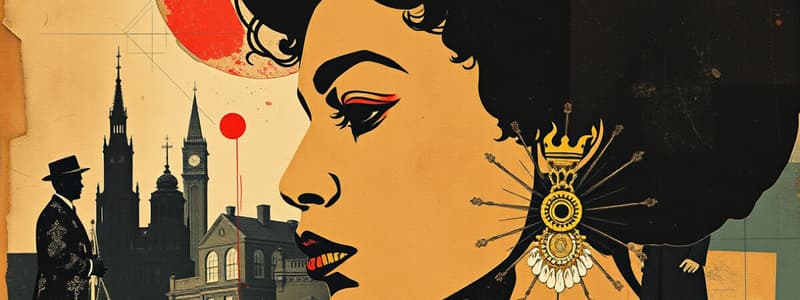Podcast
Questions and Answers
What was a major impact of the Harlem Renaissance on the cultural landscape?
What was a major impact of the Harlem Renaissance on the cultural landscape?
- It focused solely on visual arts without influence on literature.
- It led to the creation of a distinctly African American identity in art and music. (correct)
- It was primarily a movement aimed at promoting white artists.
- It discouraged black artists from addressing social issues.
Which artist is known for combining jazz and poetry during the Harlem Renaissance?
Which artist is known for combining jazz and poetry during the Harlem Renaissance?
- Aaron Douglas
- Langston Hughes (correct)
- Duke Ellington
- Louis Armstrong
What was the relationship between the Harlem Renaissance and the NAACP?
What was the relationship between the Harlem Renaissance and the NAACP?
- The NAACP was indifferent to the movement and focused solely on legal matters.
- The NAACP was founded during the Harlem Renaissance to suppress black artists.
- The NAACP supported the Harlem Renaissance by promoting black intellectuals and artists. (correct)
- The NAACP opposed the Harlem Renaissance's cultural expressions.
What type of patrons were allowed at the Cotton Club during the Harlem Renaissance?
What type of patrons were allowed at the Cotton Club during the Harlem Renaissance?
What was the primary focus of artists during the Harlem Renaissance?
What was the primary focus of artists during the Harlem Renaissance?
Flashcards are hidden until you start studying
Study Notes
Harlem Renaissance Overview
- The Harlem Renaissance was a significant black intellectual and artistic movement centered in Harlem, New York.
- It flourished during the 1920s and 1930s and continues to influence contemporary culture in various forms of art, literature, and music.
Key Movements and Terms
- Referred to as the "New Negro movement" during its peak.
- Focused on celebrating African heritage and identity through artistic expression.
Prominent Figures
- Artists like Aaron Douglas and Augusta Savage contributed works that glorified African heritage and identity.
- Intellectual leaders, including W.E.B. Du Bois, played crucial roles in activism and promoting the movement's values.
Organizations and Publications
- The NAACP was pivotal in supporting the Harlem Renaissance's growth, fostering a platform for black voices.
- The establishment of a dedicated journal provided a venue for publishing black literary works and ideas.
Music and Jazz
- Jazz emerged and gained popularity during this period, heavily influenced by black musicians.
- Notable figures such as Duke Ellington and Louis Armstrong performed at the Cotton Club, a prominent Harlem nightclub, despite its exclusive white patronage.
Cultural Fusion
- The blending of art forms was characteristic of this era, with a tendency to mix poetry and music.
- Langston Hughes was a pioneering figure known for integrating jazz rhythms with poetry, creating a unique literary style.
Studying That Suits You
Use AI to generate personalized quizzes and flashcards to suit your learning preferences.


